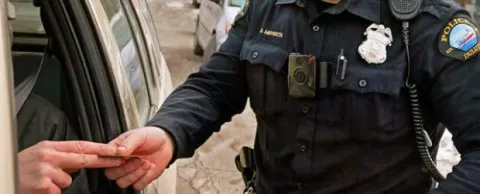
Body cameras may be one of the hottest trends in policing right now. After a number of cases of police killing unarmed suspects — and violent protests in the wake of the incidents — even the U.S. government is now talking about ways to get more local police to wear them.
Some police departments have been using them for a few years now, and Council Lead Partner Microsoft has turned their experiences into a new lessons learned report that covers many aspects of body camera programs, including privacy implications, technical limitations and overall best practices.
The report comes as body camera usage is skyrocketing. Two years ago, just 25% of agencies surveyed were using the cameras. Today, one manufacturer says 1,200 agencies are using its body cameras -- and 80% of those orders have come within just the last 12 months.
Cameras dramatically reduce complaints
Agencies that are using the body cameras have found overwhelmingly that they are the subject of significantly fewer complaints.
Rialto, Calif., performed an in-depth experiment when it first started using the cameras, randomly assigning officers to use cameras or not on each shift. In the first year, it found that officers who wore cameras were half as likely to use force and more than 90% less likely to be the subject of a complaint.
Mesa, Ariz., had similar results. Body cameras seemed to cut the number of complaints against officers by about three-quarters. It decided to deploy cameras after more citizens began using cell phones to record police. Mesa wanted its officers to be able to tell their side of the story.
And Oakland, Calif., which started deploying the cameras in 2010, found that use-of-force has declined 72%. Oakland has 700 body cameras in use -- the most of any department in the country.
Rialto’s police chief believes the cameras are putting everyone -- both the police and the people they come into contact with -- on their best behavior.
While the video footage can be useful for internal police department audits, Microsoft recommends explaining to officers that the cameras are primarily used for gathering evidence -- not for discipline. Too much emphasis on discipline can erode the trust officers have in their supervisors.
But what about privacy?
For all the benefits, privacy remains a thorny issue with no clear answers still for law enforcement agencies. The Microsoft report walks readers through the considerations.
With the exception of active investigations, in the U.S. police records are generally public records. So if you’re in distress and call police for help, there is some concern that your voice, your face and the inside of your house could end up on YouTube.
It’s not as farfetched as it might sound. Seattle police launched a YouTube channel for their body camera footage, though they blur everyone’s faces. One way to address that is to allow police to decide what, if anything, to record, the idea being that sensitive information can’t get out if it’s never recorded in the first place.
The Microsoft report quotes the American Civil Liberties Union, which argues that giving responding officers complete control over the cameras can negate any accountability or transparency benefit the cameras may have had. A U.S. Justice Department report finds that many police agencies require officers only to record traffic stops and their response to calls for service and only encounters with the public that are directly relevant to them.
Canadian disclosure laws are similar and Toronto police are wrestling with this issue too. Police there have to notify people at the first reasonable opportunity that they’re being recorded. Footage is stored on an inaccessible drive and uploaded at the end of an officer’s shift. No one -- police nor members of the public -- can view or edit the footage in the field.
Massive storage requirements
Microsoft also encourages departments to be aware of the massive amount of digital data that the body cameras can generate. It points out that Oakland’s body cameras are generating about 5 terabytes of data each month, which is more than double the volume the agency had to handle just two years ago.
Cities need to ensure their IT departments are up to the task. They also need to do a cost analysis to determine if they should manage their own video servers or use a cloud service. The cameras themselves represent one of the smallest portions of the overall cost. Systems to manage and store their output cost many times more.
Finally, Microsoft says cities need to give careful consideration to their data retention policies. The ACLU recommends that cities establish a time limit for storing video; some cities erase footage after a year, unless it’s being used for an investigation. Further, Microsoft recommends police departments have data staff members who are well versed in video, which differs greatly from every other type of record.
###
Kevin Ebi is a staff writer and social media coordinator for the Council. Follow @smartccouncil on Twitter.
Get the Smart Cities Financing Guide …
There are numerous financing tools available to help cities and regional governments pay for smart city projects like police body cameras. The Smart Cities Financing Guide provides detailed, expert analysis of 28 municipal finance tools for city leaders investing in the future. Many of the tools represent alternatives to the traditional funding mechanisms municipalities have used for decades. It’s free to Smart Cities Council members. Download your copy today.



